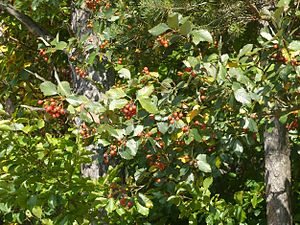Meyer's whitebeam
| Meyer's whitebeam | ||||||||||||
|---|---|---|---|---|---|---|---|---|---|---|---|---|

Sorbus meyeri , Tauberland |
||||||||||||
| Systematics | ||||||||||||
|
||||||||||||
| Scientific name | ||||||||||||
| Sorbus meyeri | ||||||||||||
| S. Hammel & Haynold |
Meyer's whitebeam ( Sorbus meyeri ) is a species of plant that belongs to the complex of bastard whitebeams ( Sorbus latifolia agg.) From the whitebeam genus ( Sorbus ) within the rose family (Rosaceae). It is the result of a hybridization of the Greek whitebeam ( Sorbus graeca sl) with the service tree ( Sorbus torminalis ). As an agamosperm species, it reproduces asexually.
description
Vegetative characteristics
Meyer's whitebeam is a slender tree that reaches heights of up to 15 meters.
The alternate arranged leaves are divided into petiole and leaf blade. The leaf stalk changes color from light green to pink in autumn. The leaf cut is reminiscent of that of a hornbeam ( Carpinus betulus ). The underside of the leaf is hairy light gray from the shoot into autumn and the upper side of the leaf is initially medium green, later darker. The leaf blade has ten to eleven pairs of leaf veins. The leaves stay on the tree for a relatively long time in autumn. Meyer's whitebeam does not react with drought damage to summer with little rain.
Generative characteristics
The dark orange to light red false fruits are (11-) 12–13 × 9.5–11 millimeters in size, the numerous lenticels in the middle of the fruit are relatively large.
Occurrence
Meyers whitebeam is a local endemic in southern Germany with main occurrences in the area around Külsheim, Hardheim and Tauberbischofsheim (Baden-Württemberg). Evidence from Bavaria is also known.
The whitebeam is usually found on shell limestone at altitudes between 280 and 415 meters. Their preferred locations are south-facing, warm slopes on the edges of forests and in poor grasslands.
Discovery and naming
Sorbus meyeri was first described by Steffen Hammel and Bernd Haynold in 2014 . The specific epithet meyeri honors Norbert Meyer , a biologist who specializes in whitebeam species, who himself described numerous new whitebeam species from Bavaria in the 1990s. The type proof is in the Natural History Museum Stuttgart (STU).
Sennikov and Kurtto have been running the species under the name Karpatiosorbus meyeri since 2017 . Christenhusz, Fay and Byng assign the whitebeam 2018 to the pear genus Pyrus and name it after one of the first descriptors Pyrus hammelii .
Endangerment and responsibility to protect
The red list of ferns and flowering plants in Germany describes Meyer's whitebeam as extremely rare. Germany is particularly responsible for their preservation.
Web links
- Blumeninschwaben.de , accessed on November 15, 2014
- [1] , accessed November 15, 2014
Individual evidence
- ↑ Distribution at bayernflora.de
- ↑ S. HAMMEL, B. HAYNOLD, 2014: Sorbus meyeri - a new species from the Sorbus latifolia group. In: Kochia , Volume 8, pp. 1–13 ( online PDF)
- ↑ N. Meyer, L. Meierott, H. SCHU FACTORY, O. ANGERER: Contributions to the genus Sorbus in Bavaria. In: Ber. Bayer. Bot. Ges. (Special volume), 2005.
literature
- Alexander Sennikov, Arto Kurtto: A phylogenetic checklist of Sorbus s. l. (Rosaceae) in Europe. In: Memoranda Soc. Fauna Flora Fennica , Volume 93, Helsinki 2017, pages 1-78. https://journal.fi/msff/article/view/64741
- Maarten MJ Christenhusz, Michael F. Fay, James W. Byng: The Global Flora Special Edition: GLOVAP Nomenclature Part 1, 2018.
- Detlev Metzing, Eckhard Garve, Günter Matze-Hajek: Red list and total species list of fern and flowering plants (Trachaeophyta) in Germany ". In: Red list of endangered animals, plants and fungi in Germany Volume 7: Plants, nature conservation and biological diversity 70 (7) , Pages 13-358.
